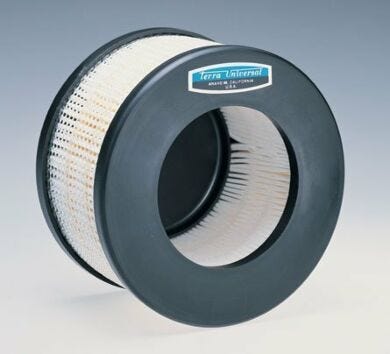- Find the right replacement specialty filter for your FFU (Fan-Filter Unit)
- Large quantities in-stock and packaged for immediate shipment
- +1 (714) 578-6100
Hours Mon - Fri, 07:00 AM - 06:00 PM (Pacific Time)


Air Filters are incorporated into the ventilation system of a cleanroom to remove an extremely wide variety of contaminants from the air, including particles smaller than a micron (.000039"). Because variables involved in such ventilation systems vary radically—depending on the exact cleanliness standard, size of facility, rate of ventilation and many other factors—filter selection must be made by a qualified engineer in cooperation with the filter manufacturer.
Once a filtering system has been selected, one problem remains: how to judge when the filter has reached its effective lifespan. Because of the wide variation in the types and concentrations of contaminants in the air being filtered, length of service and visual inspections are an unreliable guideline. The most widely used method of determining when a filter needs to be serviced or replaced is to measure the pressure drop across the filter by means of an air filter gauge.
An Air Filter Gauge measures pressure drops across the filter in order to determine whether or not the filter is operating within its design range of effective use. This is not the same as measuring filtering efficiency. Filter efficiency has to do with the ability of the filter to remove particulate matter from the air stream, and is generally measured in precisely controlled tests that vary according to the type of filter.
One method is to compare the weight of a carefully compounded dust mixture trapped in the filter with the weight of the dust released. Another method, originated by the NBS/NIST, compares the opacity of the dust collected on filter paper from two air samples of equal flow rate, one of which is filtered air. The efficiency of the filter is thus evaluated on the basis of the dust spots. A third method measures a resistance of DOP (Dioctyl-phthalate) smoke, a homogeneous aerosol of 0.3 micron size, to test a special class of high efficiency filter.
Although efficiency tests vary, the operating life of a filter is always determined by the amount of particulate dust it can hold, which in turn is related to the resistance across the filter that develops as more and more particles accumulate. An air filter gauge, by sensing the differential in static pressure across an air filter, thus permits the air filter to be used to its maximum dustholding capacity as determined by the filter manufacturer. And by indicating when a filter needs servicing, an air filter gauge can avoid excessive resistance that could disturb the balance of the system, increase air leakage and, for some types of filter, begin to pass contaminants.
All filter manufacturers supply technical data which indicate the initial resistance in inches of water column for the filter at its rated air flow, and a recommended resistance at which point the filter should be replaced or serviced. These values vary according to the type of filter. For most filters used in a cleanroom environment, however, the range between initial and replacement resistance is typically between .01 and .1" WC.
During air filter installation, air filter gauges hence provide the additional function of ensuring proper installation and proper air-flow design. The gauge should indicate a pressure resistance in conformance with the manufacturer's recommendations. If pressure is too low, the filter may be handling less than the rated air volume due to open bypasses or improper air balancing, incorrect installation or air leaks. If pressure is too high after initial assembly, the filter may be incorrectly installed or the system may be handling more than the rated air volume.
*Source: Dwyer Control & Guages
On a tight schedule? Choose FasTrak 24/7 Priority Service to help meet your critical schedule for Terra-manufactured products, either before or after your order is placed.*
Call for pricing. FasTrak service fees cover costs of additional services only, without additional profit.
* Terra's FasTrak services limited guarantee: to ship on the ESD or date specified OR to refund up to 100% of FasTrak charges. This guarantee covers no direct, special, consequential or other damages and is strictly limited to up to 100% of the amount paid for FasTrak service. When a specified ship date is missed due to factors outside Terra's control (vendor performance, deliveries by shipping companies, etc.) and random factors such as accidents, the credit of up to 100% of the FasTrak 24/7 may not apply. FasTrak service requested after order placement will be quoted and accepted based on available time remaining before required ship date.
